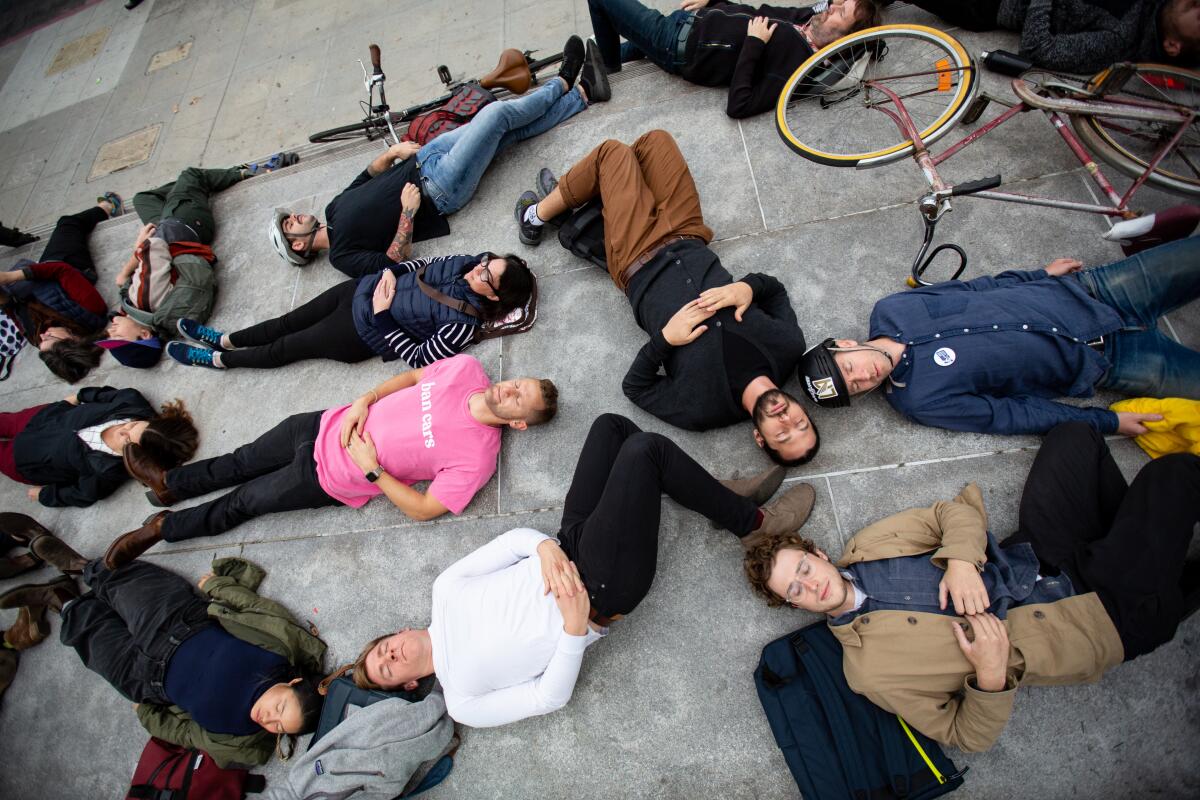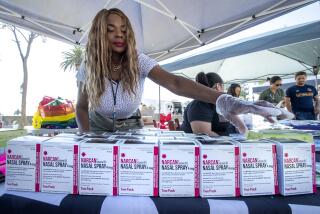As L.A. traffic deaths stay high, officials plead with drivers to stop texting

- Share via
In the fourth full year of a program designed to eliminate traffic fatalities on Los Angeles streets, the number of people killed in car crashes stayed stubbornly high, early data show.
Last year, 244 people were killed in traffic collisions on city streets, a decrease of 0.8% compared to 2018, according to preliminary figures from the city. The victims included 134 people who were walking and 19 people biking.
The data may change slightly with additional analysis, officials said. But the early figures suggest another year of lackluster progress for Vision Zero, Mayor Eric Garcetti’s initiative to eliminate traffic deaths on city streets by 2025.
Since Vision Zero was launched in 2015, the number of pedestrians, vehicle occupants, bicyclists and motorcyclists killed annually in traffic crashes has risen 33%. Fatalities surged in 2016 from 183 to 253, and have fallen 3.6% since then.
Los Angeles has yet to achieve the first major benchmark set out in Vision Zero: a 20% reduction in deaths that officials had hoped to achieve in 2017. Reducing deaths by half by 2020, the next goal on the city’s list, would require reducing fatalities this year by more than 100.
“Any life lost on our streets is one too many — and we will continue to pursue our goal of zero traffic deaths until we meet that mark,” Garcetti spokesman Alex Comisar said in a statement. He added that the mayor “urges everyone to use our streets as responsibly and safely as possible so that we can save lives together.”
The future of Vision Zero and of traffic safety in Los Angeles will be in question until the city can wean itself off its reliance on cellphones, Los Angeles Police Department Chief Michel Moore said at a recent news conference.
People who are “driving 30, 40, 50 mph ... put their head down to pick up a text or handle a call, and they move 100 yards, and they drive over someone,” Moore said. Drivers, he said, are “teaching a generation of children today in the back seat what to do with that cellphone.”
The Transportation Department made more changes to streets in L.A. in 2019 than in the prior two years combined, said spokeswoman Connie Llanos. Those 1,529 modifications to crosswalks, traffic signals, intersections and other elements of the street are designed to improve the safety of the street.
“We share in the community’s frustration, when any life is lost on our streets,” Llanos said. The department also shares in the “sense of urgency” to make changes, and has installed nearly 2,900 street safety improvements in the last three years, she said.
Many of last year’s modifications were aimed at improving safety for pedestrians, including 1,162 upgrades to crosswalks and 13 sets of flashing lights that alert drivers when someone is crossing the street.
Pedestrians are involved in a fraction of the traffic crashes in Los Angeles, but represent a disproportionate number of the victims. Over a five-year period this decade, people on foot were involved in 8% of collisions but represented 44% of those killed, according to city data.
While the number of drivers and passengers killed annually in traffic collisions has fallen across the city, the number of pedestrians killed has soared — and has remained stubbornly high. In 2019, about 55% of the people killed in traffic crashes were on foot, an increase from 40% in the year Vision Zero began.
The deaths last year included a 4-year-old girl who was struck and killed by a driver while she was walking to school with her mother in Koreatown. The driver, who made a left turn into the crosswalk, had her own children in the back seat, police said.
The girl’s death sparked an outcry among advocates, who staged a “die-in” at Los Angeles City Hall to voice their frustrations with the city’s lack of progress on Vision Zero.
Attendees said they were disturbed that the public seemingly cares very little about the hundreds of people who are killed and seriously injured in car crashes every year. The guiding philosophy of Vision Zero — that no traffic fatality is acceptable — is rarely reflected in Los Angeles, they said.
“No one is talking about it,” said Andres Quinche, a landscape architect who helped organize the protest. “What we’re lacking is courage and conviction among our political leaders, to stand up and say, ‘Safety matters more than speed.’”
The city needs more bold action to keep drivers away from pedestrians and cyclists, he said, including scaling back the space for cars on major streets to make room for bike-only and bus-only lanes.
Rather than making simple changes to intersections, the city needs to take aim at changing the city’s car culture, said John Yi, the executive director of Los Angeles Walks, a pedestrian advocacy group.
If zero deaths is really the city’s goal, “we need to have a visionary plan that matches the scope of that goal,” Yi said. “We have failed to do that.”
The Transportation Department, Llanos said in a statement, will “continue working aggressively to deliver key infrastructure and design changes to our most impacted corridors, while working with the community to build support for more transformative projects that rely on neighborhood support to be successful.”
Those changes can come with political risks. The elimination of traffic lanes on several streets in Mar Vista and Playa del Rey in 2017 sparked a massive outcry and a failed recall attempt against Councilman Mike Bonin. The city eventually undid most of the changes, but left a protected bike lane on Venice Boulevard in Mar Vista.
Moore said the LAPD also plans to work with community groups to educate pedestrians about staying alert while they cross the street. He said that even if pedestrians have the right-of-way, “that doesn’t stop a speeding car that’s paying attention to a text message rather than the roadway.”
The idea that distracted texting is as much of a problem as distracted driving, Yi said, “shows how far Los Angeles has to go on Vision Zero.”
“Just look at a three-ton vehicle that’s moving at a high speed, versus me, a bag of flesh who weighs 130 pounds,” Yi said. “It’s ridiculous.”
Times staff writer Dakota Smith contributed reporting.
More to Read
Sign up for Essential California
The most important California stories and recommendations in your inbox every morning.
You may occasionally receive promotional content from the Los Angeles Times.











